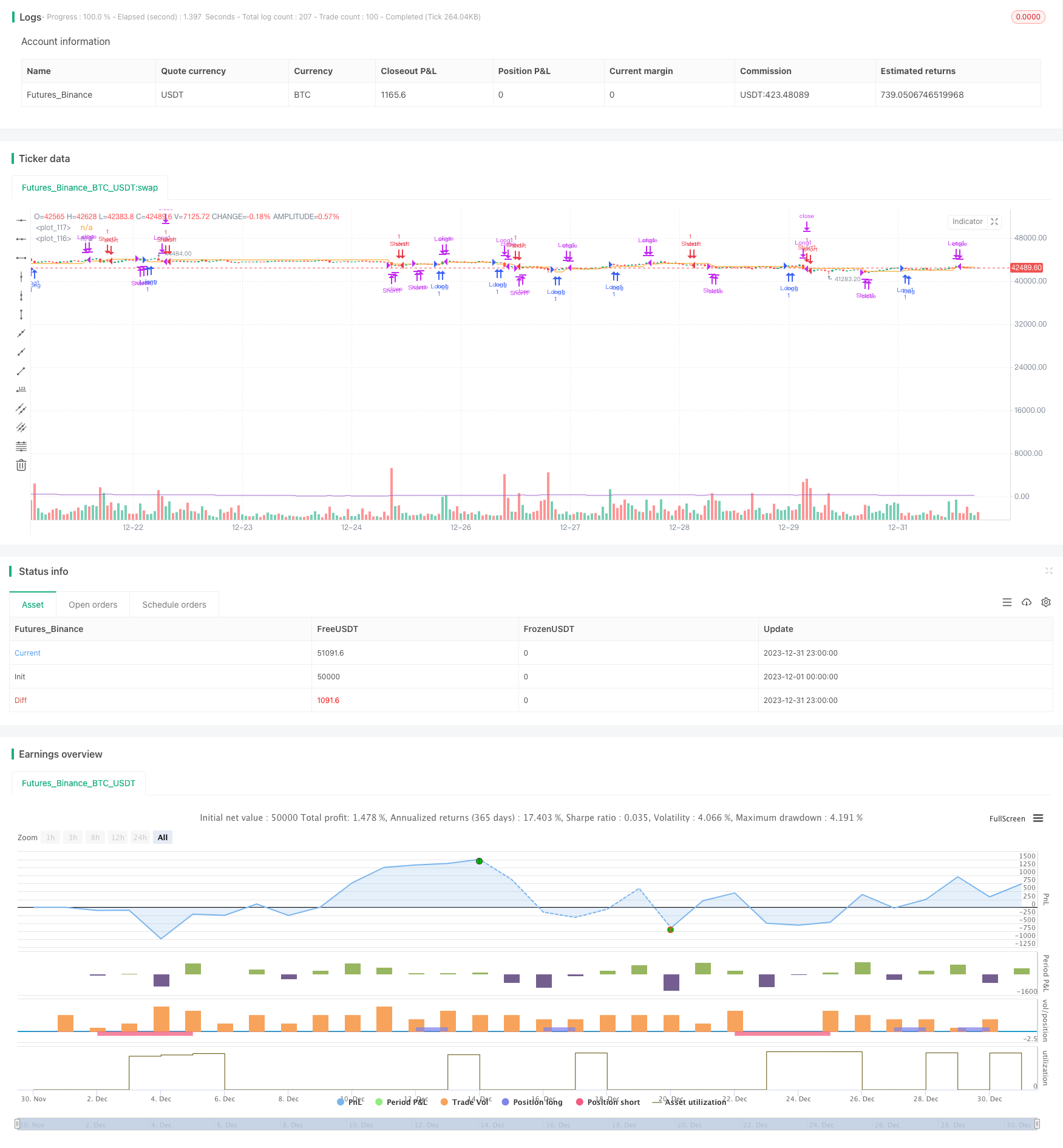
概述
本策略的主要思想是通过随机数来决定入场点,设置了三个止盈点和一个止损点来管理风险,以控制每次交易的盈亏。
策略原理
该策略使用随机数rd_number_entry在11到13之间来决定做多入场点,使用rd_number_exit在20到22之间来决定平仓。做多后设置stop loss为入场价减去atr(14)* slx。同时设置了三个止盈点,第一个止盈点为入场价加上atr(14)* tpx,第二个止盈点为入场价加上2* tpx,第三个止盈点为入场价加上3* tpx。做空的原理类似,区别在于入场决定在rd_number_entry取值不同,止盈止损方向相反。
该策略可以通过调整tpx(止盈系数)和slx(止损系数)来控制风险。
优势分析
该策略具有以下优势:
- 使用随机入场可以减少曲拟合的概率
- 设置多个止盈止损点,可以控制单笔交易的风险
- 利用atr来设置止盈止损,可以基于市场波动来设置盈亏点
- 可以通过调整系数来控制交易风险
风险分析
该策略也存在以下风险:
- 随机入场可能错过行情
- 止损点过小容易被止损
- 止盈空间过大,可能获利不足
- 参数不当可能导致亏损加大
可以通过调整止盈止损系数,优化随机入场逻辑来降低风险。
优化方向
该策略可以从以下几个方面进行优化:
- 改进随机入场逻辑,结合趋势指标判断
- 优化止盈止损系数,使盈亏比更合理
- 增加仓位控制,不同阶段采用不同的止盈空间
- 结合机器学习算法优化参数
总结
本策略以随机入场为基础,设置多个止盈止损点控制单笔交易风险,由于随机性强可以减少曲拟合概率,通过参数优化可以降低交易风险。后续优化空间还很大,值得进一步研究。
策略源码
/*backtest
start: 2023-12-01 00:00:00
end: 2023-12-31 23:59:59
period: 1h
basePeriod: 15m
exchanges: [{"eid":"Futures_Binance","currency":"BTC_USDT"}]
*/
//@version=4
strategy("Random Strategy with 3 TP levels and SL", overlay=true,max_bars_back = 50)
tpx = input(defval = 0.8, title = 'Atr multiplication for TPs?')
slx = input(defval = 1.2, title = 'Atr multiplication for SL?')
isLong = false
isLong := nz(isLong[1])
isShort = false
isShort := nz(isShort[1])
entryPrice = 0.0
entryPrice := nz(entryPrice[1])
tp1 = true
tp1 := nz(tp1[1])
tp2 = true
tp2 := nz(tp2[1])
sl_price = 3213.0
sl_price := nz(sl_price[1])
sl_atr = atr(14)*slx
tp_atr = atr(14)*tpx
rd_number_entry = 1.0
rd_number_entry := (16708 * nz(rd_number_entry[1], 1) % 2147483647)%17
rd_number_exit = 1.0
rd_number_exit := ((16708 * time % 2147483647) %17)
//plot(rd_number_entry)
shortCondition = (rd_number_entry == 13? true:false) and (year >= 2017) and not isLong and not isShort
longCondition = (rd_number_entry == 11 ? true:false) and (year >= 2017) and not isShort and not isShort
//Never exits a trade:
exitLong = (rd_number_exit == 22?true:false) and (year >= 2018) and not isShort
exitShort = (rd_number_exit == 22?true:false) and (year >= 2018) and not isLong
//shortCondition = crossunder(sma(close, 14), sma(close, 28)) and year >= 2017
//longCondition = crossover(sma(close, 14), sma(close, 28)) and year >= 2017
//exitLong = crossunder(ema(close, 14), ema(close, 28)) and year >= 2017
//exitShort = crossover(ema(close, 14), ema(close, 28)) and year >= 2017
if (longCondition and not isLong)
strategy.entry('Long1', strategy.long)
strategy.entry('Long2', strategy.long)
strategy.entry('Long3', strategy.long)
isLong := true
entryPrice := close
isShort := false
tp1 := false
tp2 := false
sl_price := close-sl_atr
if (shortCondition and not isShort)
strategy.entry('Short1', strategy.short)
strategy.entry('Short2', strategy.short)
strategy.entry('Short3', strategy.short)
isShort := true
entryPrice := close
isLong := false
tp1 := false
tp2 := false
sl_price := close+sl_atr
if (exitShort and isShort)
strategy.close('Short1')
strategy.close('Short2')
strategy.close('Short3')
isShort := false
if (exitLong and isLong)
strategy.close('Long1')
strategy.close('Long2')
strategy.close('Long3')
isLong := false
if isLong
if (close > entryPrice + tp_atr) and not tp1
strategy.close('Long1')
tp1 := true
sl_price := close - tp_atr
if (close > entryPrice + 2*tp_atr) and not tp2
strategy.close('Long2')
tp2 := true
sl_price := close - tp_atr
if (close > entryPrice + 3*tp_atr)
strategy.close('Long3')
isLong := false
if (close < sl_price)
strategy.close('Long1')
strategy.close('Long2')
strategy.close('Long3')
isLong := false
if isShort
if (close < entryPrice - tp_atr) and not tp1
strategy.close('Short1')
sl_price := close + tp_atr
tp1 := true
if (close < entryPrice - 2*tp_atr) and not tp2
strategy.close('Short2')
sl_price := close + tp_atr
tp2 := true
if (close < entryPrice - 3*tp_atr)
strategy.close('Short3')
isShort := false
if (close > sl_price)
strategy.close('Short1')
strategy.close('Short2')
strategy.close('Short3')
isShort := false
plot(atr(14)*slx)
plot(sl_price)